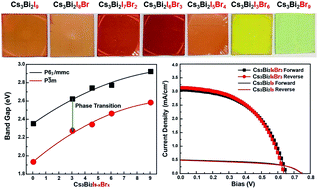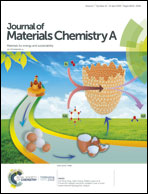Alloy-induced phase transition and enhanced photovoltaic performance: the case of Cs3Bi2I9−xBrx perovskite solar cells†
Abstract
Cs3Bi2I9 is a promising inorganic, nontoxic, and stable perovskite material for solar cell applications, but the power conversion efficiency of Cs3Bi2I9-based solar cells is relatively low because its band gap is too large and indirect. Here we show that the band gap and optoelectronic properties of Cs3Bi2I9 can be improved by alloying Br into Cs3Bi2I9, despite the common expectation that the band gap of the Cs3Bi2I9−xBrx alloy will increase with Br concentration. By systematically growing and characterizing Cs3Bi2I9−xBrx perovskite materials, we discover that at x = 3 Cs3Bi2I6Br3 shows the lowest bandgap of 2.03 eV, while that of Cs3Bi2I9 is 2.20 eV. Our photophysical characterization and density functional theory calculations show that this unusual band gap reduction and better optoelectronic properties at x ∼ 3 are mainly caused by a phase transition from the P63/mmc phase to the P![[3 with combining macron]](https://www.rsc.org/images/entities/char_0033_0304.gif) m phase. Moreover, we found that the composition engineering also leads to compact Cs3Bi2I6Br3 films with high crystallinity and orientation, which results in a champion device with a PCE of 1.15%. This novel discovery will definitely deepen our understanding of Cs3Bi2I9−xBrx materials and afford more promising strategies for highly stable lead-free perovskite optoelectronic devices.
m phase. Moreover, we found that the composition engineering also leads to compact Cs3Bi2I6Br3 films with high crystallinity and orientation, which results in a champion device with a PCE of 1.15%. This novel discovery will definitely deepen our understanding of Cs3Bi2I9−xBrx materials and afford more promising strategies for highly stable lead-free perovskite optoelectronic devices.



 Please wait while we load your content...
Please wait while we load your content...